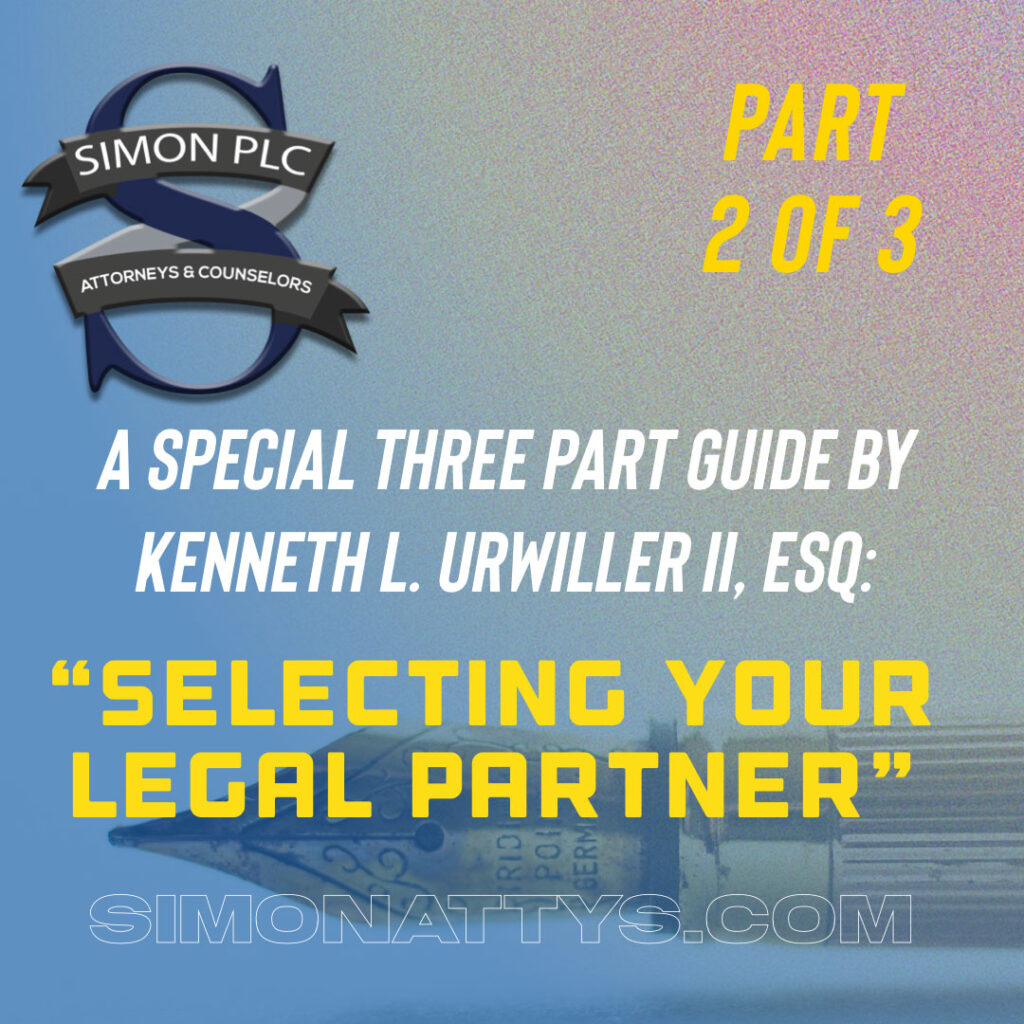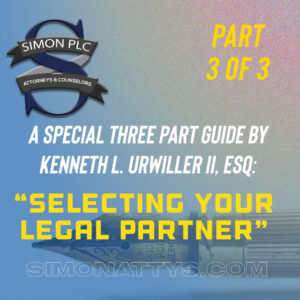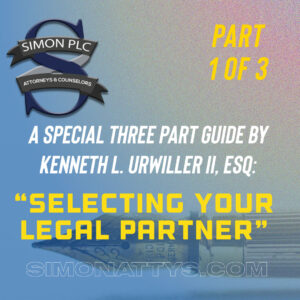Simon PLC Attorneys & Counselors – May 2022 Special Memorandum
Troy, Michigan – We are proud to continue our special three part memorandum series authored by our own Kenneth L. Urwiller II, Esq. With an outstanding career working for local Michigan and ultimately National Bank Associations, Ken brings his particular knowledge to the daily matters encountered by our clients.
In 2022 Ken has begun the process of sharing his thoughts and approaches in order to help banks and credit unions assess their litigation needs. Ken’s excellent three-part series on ‘Selecting Your Legal Partner’ continues from the very well received April 1, 2022, Part 1. – What’s your litigation culture? with this month’s installment where Ken breaks down litigation philosophies in Part 2. – How do you litigate? Next month, the final installment (publishing June 1, 2022), in Part 3 – Making Your Selections, Ken provides his insights on picking the right firm for your institution’s needs.
Please enjoy and share Ken’s thoughts with your colleagues.
Selecting Your Legal Partner
© Kenneth L. Urwiller II, Esq.
Part 2 – How do you litigate?
By Kenneth Urwiller II, Senior Attorney
If your institution does not have a legal department or General Counsel, how do you approach litigation matters? In Part 1 of this series, we began by looking inside the institution. What is your culture? What are your values, vision and mission? We defined litigation risk, time and expense tolerances. We collected, organized your past customer complaints and litigation and made some initial determinations.
Next, we will examine some common types of litigation philosophies. We will also explored your organization’s litigation risk, time and expense tolerances. Finally, we will consider the effectiveness of your policies, procedures, compliance and training programs.
Litigation philosophies
1. Fight every case to the end. This philosophy expects to convey a confidence that the institution rarely makes a mistake, and that there is real value in having a hard-hitting litigation public reputation. The assumption is that the institution will face less future litigation because the public views it as a tough opponent that is difficult to extract money from, unless the claim is exceptional, and the opponent is willing to incur significant expense and risk the uncertainty of trial.
This philosophy requires the institution to maintain a high tolerance for litigation risk, expenses and time. It involves more risk since it presumes the institution’s actions were proper and relies on others, such as judges and juries, to construe the facts and interpret the law favorably. It is time consuming and typically results in higher legal expenses, extra costs for employee participation and administrative costs. Many institutions do not adopt this philosophy for these reasons.
2. Fight every case aggressively, except those where the institution did something incorrect. This philosophy desires to convey an aggressive and competent institution that is not afraid to defend its actions but is willing to admit its mistakes and is prepared to correct them, if necessary. Following this philosophy requires the institution to have a moderately high tolerance for litigation risk and expenses. From a risk perspective, the institution must allow cases where it feels it did nothing wrong to continue to their natural conclusion. From an expense position, the organization must accept enough legal expense to gather a sufficient level of facts and documentation to make an informed determination whether its procedures violate some law or regulation or its employees made a mistake. Then it is prepared to either settle the matter or move forward with litigation. While litigation risk and expense tolerances are important factors in this approach, they are not the primary factors.
3. Focus primarily, often exclusively, on the “financial impact” of the litigation on the institution. This philosophy endeavors to extricate the institution from the litigation with the lowest possible financial impact. The expression “financial impact” is a holistic look at the entire cost of the litigation. It considers all charges associated with the case, including liability costs, outside counsel fees, expert witness fees, court costs, other outside costs and internal administrative costs such as lost employee time.
By its very nature, this approach forces the institution to be comfortable incurring expenses early in the process. It front-loads expenses because the institution, working closely with outside counsel, is interviewing employees, gathering documentation, researching legal claims to quickly develop resolution strategies. Its goal is to understand at the earliest point the organization’s risk, define the dispute’s financial impact on the institution and be able to implement strategies to resolve the matter quickly and effectively.
4. Settle all lawsuits as soon as possible. This philosophy assumes that there is tangible reputational and financial worth in avoiding protracted litigation. It represents the institution’s reluctance to engage in contentious disagreements with its customers and others in a public forum. You expect that you can achieve quick results and avoid significant legal expenses. The institution has no desire to place its reputation and litigation budget in the hands of judges and jurors, and it assigns no value to the future risk of litigation by having an aggressive litigation reputation.
This approach can lead to excessive liability exposure as cases are unnecessarily settled before the litigation risk is fully understood, or you have time to properly define the financial impact of the litigation or implement the appropriate strategies to resolve the case. It assumes this disproportionate liability exposure outweighs the litigation expense and reputational risk.
Identify your Tolerances
Now that you have completed some due diligence on your bank or credit union and familiarized yourself with some typical litigation philosophies, it’s time to begin to examine your tolerances to help determine what litigation philosophy best fits you. Let’s revisit your past customer complaint and litigation data with a focus on obtaining insight to your litigation tolerances.
Measure your institution’s litigation risk tolerance by asking yourself this question:
Is the institution comfortable risking a jury trial in hopes of winning? If it is, then your risk tolerance is reasonably high. If it is not, then your litigation risk tolerance is not high.
What does your data show? How often did your customer complaints remain unresolved and result in litigation? How often did your litigation go to trial or come close to proceeding to trial?
To analyze your litigation expense tolerance, you can examine your average litigation expenses. Remember, these are your outside litigation costs like attorney fees, filing fees and expert witness costs. Were they significant or relatively low? Does it appear you prefer to resolve matters before you incur significant litigation expenses? If you have individual cases where expenses are higher, examine them closely. Does it appear you only accept the expenses when success is probable, or do you accept them even when success is merely possible? The more you accept costs when success is unpredictable, the higher your expense tolerance is.
Your litigation expense tolerance will often mirror your litigation time tolerance. To assess your time tolerance, review the average amount of days your complaints and lawsuits remain open. Is it short or long? Such information can inform you how eager or reluctant you are to resolve these customer complaints and litigation, thus providing insight on your litigation time tolerances.
Finally, make sure you understand who makes your litigation decisions. Is it one person like the President or CEO or is it several people such as department heads? If several people make your litigation decisions, you probably have different tolerances for each person. Litigation tolerances are dynamic. They are not written in stone. They are a collection of decisions made by an individual or a group of people. As those individual decision makers change, your tolerances will change.
Review Your Litigated Policies, Procedures and Training
One final task you should consider before you determine your litigation philosophy is to review the written policies and procedures together with the compliance and training programs that resulted in the past matters you just reviewed. The documentation and strength of your organization’s policies, procedures, compliance and training programs are crucial litigation tools. They often determine your success or failure. Will your policies and procedures hold up in court? How effectively do your employees understand, are trained in and follow the institution’s policies and procedures? This is vital because it is the employees who will be your witnesses in court. They will provide the crucial testimony that will determine if your policies and procedures hold up in court. Since they are so critical, it is best to understand their strength and how well they are followed before you choose a litigation philosophy.
Develop your litigation philosophy
Now that you have familiarized yourself with some typical litigation tolerances, reviewed your recent litigation cases, determined your tolerance tendencies and reviewed your written policies, procedures, compliance and training programs, you are ready to decide what philosophy is best for you. Do you fit one of the above philosophies? Are you a hybrid of two or more or are you completely different? It is your decision. Make sure to tailor the philosophy to the types of cases you have litigated in the past as those are most likely the types of cases you will see in the future. For example, if the institution is generally successful because your policies, procedures, compliance and training for the types of issues contained in your past cases are solid and followed by your employees, you might consider a philosophy that is more aggressive. If the institution’s past litigation is less successful, the philosophy might need to be less uncompromising.
Make certain that your litigation philosophy fits within the institution’s values and vision. If the institution’s passion and mission is to create a best-in-class customer experience and be a trusted partner with a business and community focus, it may be counterproductive to employ a litigation philosophy that is overly aggressive against its customers and refuses to admit it made a mistake and accept the responsibility for its mistakes.
Finally, your philosophy needs to incorporate the institution’s tolerance for litigation risk and expense. Are you comfortable with risk or somewhat averse to it? Are legal costs an overriding concern or are business principles and institutional reputation more important? All these considerations must play in your strategic decisions.
Up Next
Now that you have determined your institution’s values and culture, reviewed your litigation tools and determined on your litigation philosophy, it’s time to research, interview and select a legal partner.
[Publishing June 1, 2022 Part 3. – Making Your Selections ]
[See also: Published April 1, 2022 Part 1. – What’s Your Litigation Culture? ]
The information contained herein is not legal advice or meant to be an exhaustive discussion of all aspects of the subject matter. It is meant solely as an introductory dialogue to assist banks and credit unions without a legal department or internal counsel to establish an approach to litigation matters.
N.B. Not Legal Advice: Please contact us if you would like to discuss the facts and circumstances of your specific matter. Simon PLC Attorneys & Counselors expressly disclaims all liability in respect to actions taken or not taken based on any or all the contents of this memorandum. The information contained herein may not reflect current legal developments and is provided without any knowledge as to the recipient’s location, industry, identity or specific circumstances. No recipients of this content, clients or otherwise, should act, or refrain from acting, on the basis of any content included in this memorandum without seeking the appropriate legal or other professional advice on the particular facts and circumstances at issue from an attorney licensed in the jurisdiction for which the recipient’s legal issue(s) involve. The application and impact of relevant laws varies from jurisdiction to jurisdiction, and our attorneys do not seek to practice law in states, territories and foreign countries where they are not properly authorized to do so.



